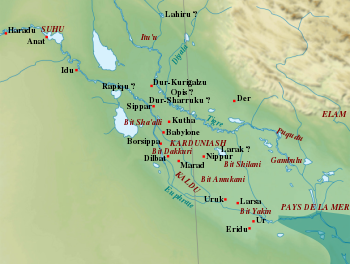
Bit-Amukani (in the Aramaic Assur Ostracon ʾwkn; Assyrian A-muk-ka-nu; Babylonian Bit U-ka-a-ni, U-ka-nu; lit. House of Amukani) was a tribe, proto-state founded by Chaldeans in southern Mesopotamia which stretched from southeast of Nippur to the area of Uruk. It is considered to have been one of the most powerful Chaldean tribes, next to Bīt-Iakin and Bīt-Dakkūri.
As early as 732 BCE, it was ruled by prince Ukinzer (also known as Mukin-zeri or Nabu-mukin-zeri) who became a king of Babylon in 732 BCE instead of Nabu-shum-ukin II whom he superseded. Later, Tiglath-pileser III devastated Bit-Amukani for the second time and defeated Mukin-zeri. Shalmaneser III (856-824) inscriptions note that two Chaldean leaders (Mušallim-Marduk of Bīt-Amukāni and Adīnu of Bīt-Dakkūri) carried silver, gold, tin, bronze, elephant tusks, elephant skins, ebony and sissoowood (or meskannu wood) as a tribute to the King of Assyria.
Though unconfirmed, the economy of Bīt-Amūkāni probably relied on producing dates.
Tiglath-pileser III described his genocide of Bit-Amukani with the words: "the land Bit-Amukani I threshed as with a threshing instrument. I took all of its people (and) its property to Assyria." Although Tiglath-pileser III's writings testify about conflict with Bīt-Amūkāni, Bīt-Amūkāni never went extinct but actually remained important through later Babylonian history.
Sennacherib's inscriptions note that Bit-Amukani consisted of 39 walled cities and 350 villages. Its capital was Sapia (Assyrian Sapīya or Šapīya).
List of Bīt-Amūkāni leaders
| Name | Reign | Comments | |
|---|---|---|---|
| Mušallim-Marduk | somewhere during Shalmaneser III | gave tribute to Shalmaneser III in 850 | |
| (Nabû-)mukīn-zēri, king | 731–729 | deposed by Tiglath-pileser III; besieged in Šapīya, but not captured father of Šuma-ukīn | |
| Ea-zēra-(i)qīša | 673 > time of Ashurbanipal | held hostage in Assyria during rebellion of 652–648; his mother was Humbušte (or Humbuštu); assured loyalty of Bit Amukani to Ashurbanipal | |
| ? Kudurru | ca. rebellion of 652–648? | position in tribe uncertain, according to Lipinski governor of Uruk; probably was not Bit-Amukanean, but rather installed by Ashurbanipal |
References
- Zadok, Ran (1985). On West Semites in Babylonia during the Chaldean and Achaemenian Periods: An Onomastic Study. pp. 58–62.
- ^ Tadmor, Hayim (2011). The royal inscriptions of Tiglath-pileser III (744–727 BC) and Shalmaneser V (726–722 BC), kings of Assyria. Yamada, Shigeo., Novotny, Jamie R. Winona Lake, Ind.: Eisenbrauns. p. 18. ISBN 978-1-57506-657-8. OCLC 774282690.
- Younger, K. Lawson Jr. (2016). A political history of the Arameans: from their origins to the end of their polities. Atlanta. p. 676. ISBN 978-1-58983-128-5.
{{cite book}}: CS1 maint: location missing publisher (link) - Frame, Grant. "The Political History and Historical Geography of the Aramean, Chaldean, and Arab Tribes in Babylonia in the Neo-Assyrian Period".
{{cite journal}}: Cite journal requires|journal=(help) - Lipinski, Edward (31 December 2000). Aramaeans: Ancient History, Culture. Peeters Publishers. p. 435. ISBN 978-90-429-0859-8.